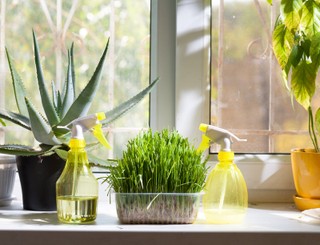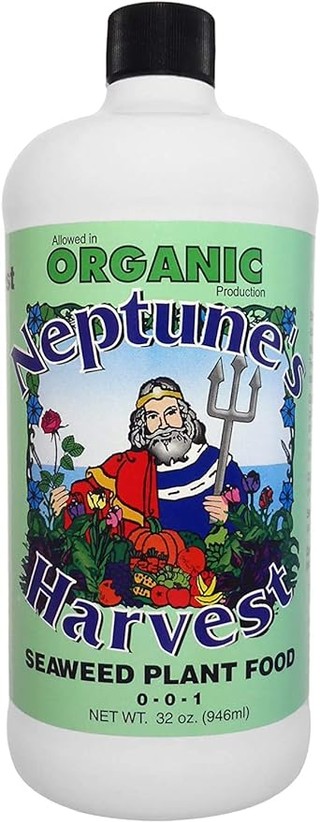Everything you need to know about liquid seaweed fertilizer
- What is liquid seaweed fertilizer?
- Key components and their benefits
- Application techniques
- Advantages of liquid seaweed fertilizer
- Disadvantages of liquid seaweed fertilizer
- How to make your own liquid seaweed fertilizer
- Ideal plants for liquid seaweed fertilizer
- Plants to use cautiously with liquid seaweed fertilizer
- Is liquid seaweed fertilizer safe for all plants?
- Application tips and best practices

Hey there, green thumbs! 🌿
Let’s talk about liquid seaweed fertilizer, especially the kelp kind.
This isn’t just your average plant food; it’s a powerhouse of nutrients, perfect for those into organic gardening.
Eager to see how this seaweed extract can transform your garden?
Let’s jump right in!
What is liquid seaweed fertilizer?

Liquid seaweed fertilizer consists of Ascophyllum nodosum kelp, harvested from cold, nutrient-rich waters, transformed into a liquid gold for your plants.
This isn’t ordinary garden fertilizer; it’s a mix of growth hormones, micronutrients, and biostimulants, all wrapped up in an organic, water-soluble package.
Here’s a snapshot of what makes it so special:
- Growth hormones: They’re like a turbo boost for your plant’s growth.
- Micronutrients: Think of these as the essential vitamins for your plants’ health.
- Biostimulants: Supercharge your plants’ ability to absorb nutrients and thrive.
- Water soluble: This means your plants get to drink up all that goodness more easily.
- Organic: Ideal for keeping your gardening game all-natural.
Compared to fish fertilizer
While fish fertilizer is known for its high nitrogen content, liquid seaweed excels in providing a broad range of micronutrients and growth hormones.
Fish fertilizer is great for quick growth, but seaweed offers more comprehensive support, including promoting root development and boosting plant health.
Compared to other garden fertilizers
Many garden fertilizers focus primarily on NPK (nitrogen, phosphorus, potassium) ratios.
Liquid seaweed, on the other hand, shines in its micronutrient profile and growth-stimulating hormones like cytokinins, gibberellins, and auxins.
So, if you’re weighing your options between fish fertilizer, traditional garden fertilizers, and liquid seaweed, think about what your plants need most.
If it’s a well-rounded, health-boosting solution you’re after, liquid seaweed might be your best bet.
Key components and their benefits
Liquid kelp fertilizer’s exceptional benefits stem from its unique composition, which includes a range of natural components not typically found in standard fertilizers.
These components are known as plant growth regulators and contribute significantly to the overall effectiveness of the fertilizer:
- Broad spectrum of nutrients: Kelp, being a marine-based product, contains almost all elements from the periodic table, offering a comprehensive range of nutrients to plants.
- N-P-K value and microorganisms: The lower N-P-K value in seaweed products is offset by the nutrients’ availability for plant uptake and reduced leaching, thanks to the microorganisms in seaweed fertilizers.
- Potassium: Potassium enhances plant hardiness, regulates stomatal activity under drought stress, activates antioxidant systems under cold stress, and strengthens cell walls against pathogens.
- Growth hormones: Rich in phytohormones such as auxins, cytokinins, gibberellins, abscisic acid, and ethylene, these regulate various aspects of plant growth.
- Amino acids: Essential both within plants and in the soil, amino acids are used as building blocks for proteins and metabolic processes, and they strengthen soil microbial colonies.
- Bioactive carbohydrates: Unique complex polysaccharides in seaweed improve soil structure and trigger plants’ natural defense mechanisms.
- Beneficial bacteria and fungi: Supplementing natural soil bacteria and fungi, these organisms promote plant and root growth and increase disease and salinity resistance.
The benefits of liquid seaweed fertilizer
Now that we understand the key components, let’s look at the benefits they bring to your garden:
Boosts plant growth with hormones
The growth hormones in liquid seaweed play a pivotal role in plant development, promoting cell division, root growth, stem elongation, and seed germination.
Improves plant health with essential micronutrients
This fertilizer is packed with essential micronutrients like potassium, magnesium, zinc, and iron, which are fundamental for plant growth and health.
Enhances soil health and structure
Components like alginic acid and mannitol improve soil structure and water retention, enhancing overall soil health.
Reducing nutrient leaching
Liquid seaweed fertilizer reduces nutrient leaching, keeping the nutrients in the soil longer and providing sustained nourishment.
Efficient nutrient uptake
The composition of liquid seaweed ensures efficient nutrient uptake by plants, leading to healthier growth and stronger root systems.
Additional benefits
- Resistance to stress: Plants become more resilient to environmental stressors.
- Enhances seed germination: Growth hormones and micronutrients aid effective seed germination.
- Improves flowering and fruiting: Expect more abundant and vibrant flowering and fruiting.
- Environmentally friendly: As an organic product, it’s a sustainable choice for the environment.
With its unique components and wide-ranging benefits, liquid seaweed fertilizer is a valuable addition to any gardening regimen, promoting plant health and contributing to a healthier gardening ecosystem.
In the next section, we’ll explore how to apply this nutrient-rich liquid to achieve the best results in your garden.
Application techniques

Now, let’s talk about getting this liquid seaweed magic onto your plants.
There are a couple of ways to do it – through foliar spray or soil drench. Both methods are super effective, but they serve different purposes:
- Foliar spray: Grab your sprayer and get ready to mist your plants. This method is all about spraying the leaves directly. It’s like giving your plants a quick nutrient shower – they absorb the goodness right through their leaves.
- Soil drench: This is more like a deep, nourishing drink for the roots. Mix the liquid seaweed fertilizer with a gallon of water (following the product’s dilution instructions) and pour it around the base of your plants. It helps improve root development and overall soil structure.
Just remember, a little goes a long way. Stick to the recommended application rates to avoid overdoing it.
Advantages of liquid seaweed fertilizer
Here’s why pro gardener love liquid seaweed fertilizer:
- Boosts plant growth: Thanks to cytokinins, gibberellins, and auxins, expect to see some happy, flourishing plants.
- Enhances soil health: It’s not just good for plants; it improves soil structure too, making it a win-win.
- Rich in micronutrients: Plants love these tiny yet mighty nutrients, and liquid seaweed’s got plenty of them.
- Promotes root growth: Strong roots mean strong plants, and this fertilizer is a champion in stimulating root development.
- Safe and organic: Being OMRI listed, you know it’s safe for all your organic gardening needs.
So, whether you’re nurturing houseplants, tending to your vegetable garden, or caring for flowers, this fertilizer is like a secret garden superhero.
But, as with all heroes, it’s not perfect. Let’s look at some of its flaws.
Disadvantages of liquid seaweed fertilizer
While liquid seaweed fertilizer is fantastic, there are a couple of things to keep in mind:
- Cost: Quality comes with a price. It’s more expensive than your average fertilizer.
- Shelf life: It’s not the kind of thing you buy in bulk and forget about. Use it up while it’s fresh and effective.
- NPK ratio: It’s low in NPK (nitrogen, phosphorus, potassium), so you might need to supplement it with other fertilizers for balanced nutrition.
With these pros and cons in mind, let’s find out which plants will love this seaweed treat the most.
How to make your own liquid seaweed fertilizer
Fancy a bit of DIY? Making your own liquid seaweed fertilizer can be a rewarding project. Here’s how you can create this nutrient-rich concoction at home:
-
Gather your materials: You’ll need fresh seaweed (make sure it’s legal to harvest in your area) and a large container with a lid. If you can’t access fresh seaweed, dried seaweed works too – just rehydrate it before use.
-
Clean the seaweed: Rinse the seaweed thoroughly to remove salt, sand, and other sea residues. Freshwater is fine for this task.
-
Prepare the container: Place the cleaned seaweed in your container. If you’re using a bucket, fill it about halfway.
-
Add water: Cover the seaweed with water. If you’re using a closed container, leave some room for expansion as gases will form during fermentation.
-
Let it ferment: Seal the container and leave it in a spot where the smell won’t be a bother (it can get quite pungent). The fermentation process takes about 3-4 weeks. Stir the mixture every few days to aerate it.
-
Strain and store: Once fermented, strain the mixture. The remaining liquid is your homemade liquid seaweed fertilizer. Store it in a cool, dark place.
-
Dilute before use: Remember to dilute it before applying – a general guideline is to dilute it to the color of weak tea.
Creating your own liquid seaweed fertilizer is a great way to recycle natural resources and provide your plants with a homemade nutrient boost.
Now that we’ve covered making your own fertilizer, let’s explore which plants will thrive with this seaweed treat.
Ideal plants for liquid seaweed fertilizer

Liquid seaweed fertilizer is not just versatile, it’s a favorite in the plant kingdom. However, certain plants show a particularly positive response:
Vegetables
- Leafy greens: Lettuce, spinach, and kale show improved growth and health.
- Root vegetables: Carrots and beets benefit from enhanced root development.
- Cruciferous vegetables: Broccoli and cauliflower show improved resilience to stress.
Flowers
- Annuals and perennials: Liquid seaweed promotes vibrant blooms and robust growth.
- Bulbs: Tulips and daffodils benefit from improved flowering and bulb health.
Fruit trees
Citrus and apple trees show increased fruit yield and better resistance to environmental stresses.
Lawns
Liquid seaweed promotes a lush, green appearance and robust root development.
Houseplants
Some houseplants, especially tropical and foliage plants, thrive with the gentle nourishment from liquid seaweed.
Herbs
Culinary herbs like basil, parsley, and cilantro show more robust growth and richer flavor.
These plants generally respond well to liquid seaweed, but always consider each plant’s specific needs.
Plants to use cautiously with liquid seaweed fertilizer
While many plants thrive with liquid seaweed, some need a more cautious approach:
Sensitive plants
Orchids and ferns are delicate plants that might prefer a more diluted solution.
Plants preferring low nutrient soil
Some succulents and wildflowers thrive in low-nutrient conditions and might be overwhelmed by rich fertilizers.
Seedlings
Use a highly diluted solution to avoid overwhelming these young plants.
Plants with specific nutrient requirements
Acid-loving plants like azaleas may require additional fertilization to meet their specific needs.
By understanding the needs of your plants, you can use liquid seaweed fertilizer effectively without causing harm.
In the next section, we’ll address the safety of liquid seaweed fertilizer for all plants, including herbs, vegetables, and flowers.
Is liquid seaweed fertilizer safe for all plants?
One of the most common questions gardeners have is about the safety of liquid seaweed fertilizer for different plant types. Here’s what you need to know:
- Broad compatibility: Liquid seaweed fertilizer is generally safe for most plants, including herbs, vegetables, and flowers. Its organic and gentle nature makes it a versatile choice for various gardening needs.
- Safe for culinary and medicinal herbs: It’s ideal for herbs as it promotes healthy growth without the risk of chemical residues.
- Boosts vegetable health: Great for vegetable gardens, it enhances growth and improves resilience against environmental stress.
- Beneficial for flowering plants: Flowers benefit from the micronutrients and hormones in liquid seaweed, resulting in vibrant blooms.
Special considerations
- Dilution is key: Always dilute the fertilizer according to the instructions. Over-concentration can harm sensitive plants.
- Observe plant response: Monitor how your plants respond to the fertilizer and adjust usage accordingly.
- Combining with other fertilizers: In some cases, plants may require additional nutrients not provided by seaweed alone. In such instances, it’s safe to use liquid seaweed in conjunction with other fertilizers.
By using liquid seaweed fertilizer thoughtfully and observing your plants’ reactions, you can safely incorporate it into your gardening routine for a wide range of plants.
Next, let’s delve into the application tips and best practices to get the most out of this natural wonder.
Application tips and best practices

To maximize the benefits of liquid seaweed fertilizer, it’s important to use it correctly. Here are some tips and best practices for application:
Dilution ratios
- Follow product guidelines: The dilution ratio varies by product. Generally, dilute the fertilizer to the color of weak tea.
- Seedlings and delicate plants: Use a more diluted mixture to avoid overwhelming them.
Application frequency
- Regular feeding: Apply every 2-4 weeks during the growing season for optimal results.
- Observe plant response: Adjust frequency based on how your plants react. Some may benefit from more frequent applications, while others may need less.
Application methods
- Foliar spray: Spray directly onto the leaves for quick nutrient absorption. Best done in the early morning or late afternoon to avoid evaporation.
- Soil drench: Apply around the base of the plant to nourish the roots. This method is particularly effective for root development.
Combining with other fertilizers
- Complementary use: Liquid seaweed can be used in conjunction with other fertilizers. Ensure you’re not over-fertilizing by adjusting quantities accordingly.
Seasonal considerations
- Growing season: Most beneficial when used during the active growing season of plants.
- Dormant period: Reduce or stop applications during the plant’s dormant period.
Storage and shelf life
- Proper storage: Store in a cool, dark place to maintain its efficacy.
- Mind the shelf life: Use it within the recommended time frame for the best results.
By following these tips and best practices, you can ensure that your plants receive the full benefits of liquid seaweed fertilizer, leading to a healthier and more vibrant garden.
And if you want our recommendation, go with this one from Neptune’s Harvest. It’s high in phosphorous content and doesn’t leave a strong odor.

Neptune's Harvest seaweed fertilizer (36 oz)
- Made from seaweed (ascophyllum nodosum)
- Sourced from north Atlantic ocean
- Formulation is designed to be diluted and used immediately
Good luck! 🍀
